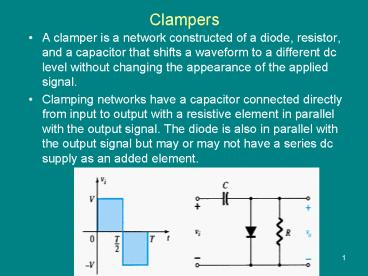Clampers - PowerPoint PPT Presentation
1 / 21
Title:
Clampers
Description:
Clamping networks have a capacitor connected directly from input ... The diode is also in parallel with the output signal but may or ... the Kirchoff's Law. VC ... – PowerPoint PPT presentation
Number of Views:488
Avg rating:3.0/5.0
Title: Clampers
1
Clampers
- A clamper is a network constructed of a diode,
resistor, and a capacitor that shifts a waveform
to a different dc level without changing the
appearance of the applied signal. - Clamping networks have a capacitor connected
directly from input to output with a resistive
element in parallel with the output signal. The
diode is also in parallel with the output signal
but may or may not have a series dc supply as an
added element.
2
- There is a sequence of steps that can be applied
- Examine the response of the portion of the input
signal that will forward bias the diode. If the
diode is reverse bias, skip the analysis for that
interval time, and start analysis for the next
interval time. - During the period that the diode is in the on
state, assume that the capacitor will charge up
instantaneously to a voltage level determined by
the surrounding network. - Assume that during the period when the diode is
in the off state the capacitor holds on to its
established voltage level. - Maintain awareness of the location and defined
polarity for vo to ensure that the proper levels
are obtained. - Check that the total swing of the output matches
that of the input.
3
Analysis of the previous network
- Diode on and
- vo 0
- Diode off and vo-2V
4
- Magnitude of R and C must be appropriate to
ensure ?RC where the time constant is large
enough and capacitor may not discharge during the
time interval while diode is not conducting - We will assume for practical purposes the
capacitor will fully charge or discharge in 5
time constant.
5
Example
- Determine Vo for the below network.
6
Solution
- f1000Hz, so a period of 1ms or interval 0.5ms
between each level. - the diode will start to conduct (t1 till t2), and
then V05V. - from the Kirchoffs Law
- VC20V5V25V
- in the next positive half cycle, we will find
V035V(outside loop) - Time constant, ? RC 10ms, total discharge time
50ms where is large enough before the capacitor
is discharged during interval t2 till t3
7
Output waveform
8
Example
- Repeat previous example using a silicon diode
with V? 0.7 V. Solution
9
Solution
- Diode is on, then vo4.3 V and Vc 24.3 V
- Diode is off, then vo34.3 V
10
(No Transcript)
11
(No Transcript)
12
(No Transcript)
13
(No Transcript)
14
- The input signal can be any type of waveform
- - sine, square, triangle wave, etc.
- .
15
VOLTAGE-MULTIPLIER CIRCUITS
- Voltage-multiplier circuits are employed to
maintain a relatively low transformer peak
voltage while stepping up the peak output voltage
to two, three, four, or many times the peak
rectified voltage.
16
Voltage-Doubler
17
- ve half cycle -ve half cycle
18
How does a Voltage-Doubler work
- During the positive voltage half-cycle diode D1
conducts (and diode D2 is cut off), charging
capacitor C1 up to the peak rectified voltage
(Vm) with the polarity shown in figure. - During the negative half-cycle D1 is cut off and
diode D2 conducts charging capacitor to 2 Vm
19
Voltage Doubler
20
ve half cycle -ve half cycle
21
Voltage Tripler and Quadrupler































